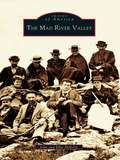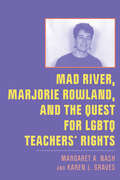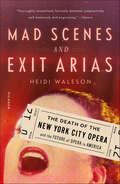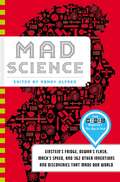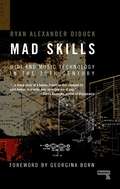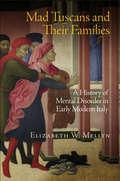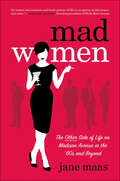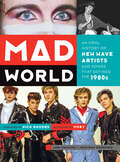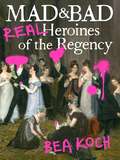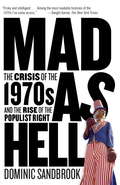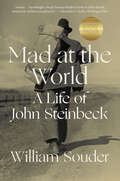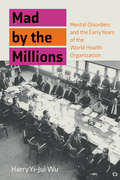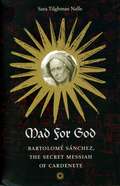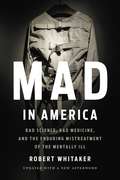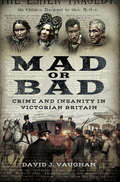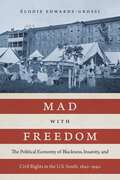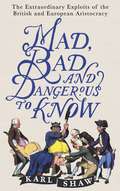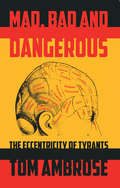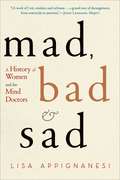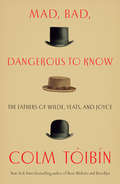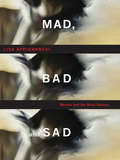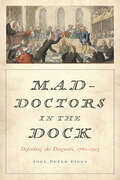- Table View
- List View
Mad River Valley, The (Images of America)
by Ellie Hilferty John HilfertyBeginning as an icy trickle in the Green Mountains of Vermont, the northward-flowingMad River and its scenic valley have changed little since being settled after the Revolutionary War. The valley's dairy farms, terraced meadows, upland forests, nineteenth-century villages, country inns, and classic ski resorts attract a half-million tourists each year. The historic photographs in The Mad River Valley show slices of daily life in the valley's five towns: Warren, Waitsfield, and Moretown, which lie in the river's path; and Fayston and Duxbury, on the valley's western slope. The area's economy, driven and sustained by river-powered mills and logging, plus sheep, then dairy farming, eventually gave way to the more spirited pastimes of skiing, hiking, fishing, and biking, all dictated by the lay of the land and the flow of the river.
Mad River, Marjorie Rowland, and the Quest for LGBTQ Teachers’ Rights (New Directions in the History of Education)
by Margaret A. Nash Karen L. GravesMad River, Marjorie Rowland, and the Quest for LGBTQ Teachers’ Rights addresses an important legal case that set the stage for today’s LGBTQ civil rights–a case that almost no one has heard of. Marjorie Rowland v. Mad River School District involves an Ohio guidance counselor fired in 1974 for being bisexual. Rowland’s case made it to the U.S. Supreme Court, but the justices declined to consider it. In a spectacular published dissent, Justice Brennan laid out arguments for why the First and Fourteenth Amendments apply to bisexuals, gays, and lesbians. That dissent has been the foundation for LGBTQ civil rights advances since. In the first in-depth treatment of this foundational legal case, authors Margaret A. Nash and Karen L. Graves tell the story of that case and of Marjorie Rowland, the pioneer who fought for employment rights for LGBTQ educators and who paid a heavy price for that fight. It brings the story of LGBTQ educators’ rights to the present, including commentary on Bostock v Clayton County, the 2020 Supreme Court case that struck down employment discrimination against LGBT workers.
Mad Scenes and Exit Arias: The Death of the New York City Opera and the Future of Opera in America
by Heidi WalesonFrom the Wall Street Journal’s opera critic, a history of how and why the New York City Opera went bankrupt—and what it means for the future of the arts.In October 2013, the arts world was rocked by the news that the New York City Opera—“the people’s opera”—had finally succumbed to financial hardship after 70 years in operation. The company had been a fixture on the national opera scene—as the populist antithesis of the grand Metropolitan Opera, a nurturing home for young American talent, and a place where new, lively ideas shook up a venerable art form. But NYCO’s demise represented more than the loss of a cherished organization: it was a harbinger of massive upheaval in the performing arts—and a warning about how cultural institutions would need to change in order to survive.Drawing on extensive research and reporting, Heidi Waleson, one of the foremost American opera critics, recounts the history of this scrappy company and reveals how, from the beginning, it precariously balanced an ambitious artistic program on fragile financial supports. Waleson also looks forward and considers some better-managed, more visionary opera companies that have taken City Opera’s lessons to heart.Above all, Mad Scenes and Exit Arias is a story of money, ego, changes in institutional identity, competing forces of populism and elitism, and the ongoing debate about the role of the arts in society. It serves as a detailed case study not only for an American arts organization, but also for the sustainability and management of nonprofit organizations across the country.“An intricate whodunit that seeks to find out who murdered the New York City Opera. . . . Waleson gives us a vivid description of each death-defying crisis and a sharp portrait of the ever-changing cast of would-be saviors who somehow always failed in their mission.” —The New York Times Book Review“Thoroughly researched, factually detailed, judgmentally well-balanced, and engrossing.” —Opera“Waleson’s in-depth study illustrates the challenges City Opera—and other opera houses—face in the 21st century as they seek to preserve tradition and innovate.” —Publishers Weekly“A thorough recounting of the tumultuous history of the New York City Opera [and] a cleareyed examination of the economic fragility of cultural institutions.” —Kirkus Reviews
Mad Science: Einstein's Fridge, Dewar's Flask, Mach's Speed, and 362 Other Inventions and Discoveries That Made Our World
by Randy Alfred365 days of inventions, discoveries, science, and technology, from the editors of Wired Magazine.On January 30, Rubik applied for a patent on his cube (1975). On the next day, 17 years earlier, the first U.S. Satellite passed through the Van Allen radiation belt. On March 17, the airplane "black box" made its maiden voyage (1953). And what about today? Every day of the year has a rich scientific and technological heritage just waiting to be uncovered, and Wired's top-flight science-trivia book MAD SCIENCE collects them chronologically, from New Year's Day to year's end, showing just how entertaining, wonderful, bizarre, and relevant science can be.In 2010, Wired's popular "This Day in Tech" blog peaked with more than 700,000 page views each month, and one story in 2008 drew more than a million unique viewers. This book will collect the most intriguing anecdotes from the blog's run-one for each day of the year-and publish them in a package that will instantly appeal to hardcore techies and curious laypeople alike.
Mad Skills: MIDI and Music Technology in the Twentieth Century
by Ryan DiduckA cultural history of MIDI (the Musical Instrument Digital Interface), one of the most revolutionary and transformative technologies in the history of music.A history of electronic music that goes way beyond the Moog. Part rigorous history, part insightful commentary, and part memoir, Mad Skills tells the story behind MIDI, aka the Musical Instrument Digital Interface, through the twentieth century's kaleidoscopic lens. Guiding us across one hundred years of musical instruments, and the music made with them, Mad Skills recounts the technical and creative innovations that led to the making of the most vital, long-standing, ubiquitous, and yet invisible music technology of our time.
Mad Tuscans and Their Families
by Elizabeth W. MellynBased on three hundred civil and criminal cases over four centuries, Elizabeth W. Mellyn reconstructs the myriad ways families, communities, and civic and medical authorities met in the dynamic arena of Tuscan law courts to forge pragmatic solutions to the problems that madness brought to their households and streets. In some of these cases, solutions were protective and palliative; in others, they were predatory or abusive. The goals of families were sometimes at odds with those of the courts, but for the most part families and judges worked together to order households and communities in ways that served public and private interests.For most of the period Mellyn examines, Tuscan communities had no institutions devoted solely to the treatment and protection of the mentally disturbed; responsibility for their long-term care fell to the family. By the end of the seventeenth century, Tuscans, like other Europeans, had come to explain madness in medical terms and the mentally disordered were beginning to move from households to hospitals. In Mad Tuscans and Their Families, Mellyn argues against the commonly held belief that these changes chart the rise of mechanisms of social control by emerging absolutist states. Rather, the story of mental illness is one of false starts, expedients, compromise, and consensus created by a wide range of historical actors.
Mad Women: The Other Side of Life on Madison Avenue in the '60s and Beyond
by Jane MaasA New York copywriter reveals what it was like to be a woman in the 1960s male-dominated advertising world depicted in the hit show Mad Men.What was it like to be an advertising woman on Madison Avenue in the ‘60s and ‘70s—that Mad Men era of casual sex and professional serfdom? A real-life Peggy Olson reveals it all in this immensely entertaining and bittersweet memoir.Fans of the show are dying to know how accurate it is: was there really that much sex at the office? Were there really three-martini lunches? Were women really second-class citizens? Jane Maas says the answer to all three questions is unequivocally “yes.” Her book, based on her own experiences and on countless interviews with her peers, gives the full stories, from the junior account man whose wife almost left him when she found the copy of Screw magazine he’d used to find “a date” for a client, to the Ogilvy & Mather’s annual Boat Ride, a sex-and-booze filled orgy, from which it was said no virgin ever returned intact. Wickedly funny and full of juicy inside information, Mad Women also tackles some of the tougher issues of the era, such as unequal pay, rampant, jaw-dropping sexism, and the difficult choice many women faced between motherhood and their careers.
Mad World: An Oral History of New Wave Artists and Songs That Defined the 1980s
by Jonathan Bernstein Lori MajewskiA &“hugely entertaining&” history of the 1980s New Wave music scene told through new interviews with its biggest artists (Rolling Stone). Mad World is a compelling oral history that celebrates the New Wave music phenomenon of the 1980s via new interviews with 35 of the most notable artists of the period. Each chapter begins with a discussion of their most popular song and leads to stories of their history and place in the scene, ultimately painting a vivid picture of this colorful, idiosyncratic time. Mixtape suggestions, fashion sidebars, and quotes from famous contemporary admirers help fill out the fun. Participants include members of Duran Duran, New Order, The Smiths, Tears for Fears, Adam Ant, Echo, and the Bunnymen, Devo, ABC, Spandau Ballet, A Flock of Seagulls, Thompson Twins, INXS, and more. &“One addictive chapter after another.&” —Rob Sheffield, author of Talking to Girls About Duran Duran &“Tells the tale of some of the decade&’s most unforgettable songs . . . in fascinating detail, letting the architects of these memorable records shine a light on how the sound of a generation came to be.&” —The Hollywood Reporter &“The new wave era is often dismissed for its one-hit wonders and silly haircuts, but [Mad World] examines the period with a great deal of love and reverence.&” —Buzzfeed &“A really informative and insightful read.&” —People
Mad and Bad: Real Heroines of the Regency
by Bea KochDiscover a feminist pop history that looks beyond the Ton and Jane Austen to highlight the Regency women who succeeded on their own terms and were largely lost to history -- until now.Regency England is a world immortalized by Jane Austen and Lord Byron in their beloved novels and poems. The popular image of the Regency continues to be mythologized by the hundreds of romance novels set in the period, which focus almost exclusively on wealthy, white, Christian members of the upper classes.But there are hundreds of fascinating women who don't fit history books limited perception of what was historically accurate for early 19th century England. Women like Dido Elizabeth Belle, whose mother was a slave but was raised by her white father's family in England, Caroline Herschel, who acted as her brother's assistant as he hunted the heavens for comets, and ended up discovering eight on her own, Anne Lister, who lived on her own terms with her common-law wife at Shibden Hall, and Judith Montefiore, a Jewish woman who wrote the first English language Kosher cookbook.As one of the owners of the successful romance-only bookstore The Ripped Bodice, Bea Koch has had a front row seat to controversies surrounding what is accepted as "historically accurate" for the wildly popular Regency period. Following in the popular footsteps of books like Ann Shen's Bad Girls Throughout History, Koch takes the Regency, one of the most loved and idealized historical time periods and a huge inspiration for American pop culture, and reveals the independent-minded, standard-breaking real historical women who lived life on their terms. She also examines broader questions of culture in chapters that focus on the LGBTQ and Jewish communities, the lives of women of color in the Regency, and women who broke barriers in fields like astronomy and paleontology. In Mad and Bad, we look beyond popular perception of the Regency into the even more vibrant, diverse, and fascinating historical truth.
Mad as Hell: The Crisis of the 1970s and the Rise of the Populist Right
by Dominic Sandbrook"I'm mad as hell, and I'm not going to take it anymore!" The words of Howard Beale, the fictional anchorman in the 1970s hit film Network, struck a chord with a generation of Americans. From the disgrace of Watergate to the humiliation of the Iran hostage crisis, the American Dream seemed to be falling apart. In this magisterial new history, Dominic Sandbrook re-creates the schizophrenic atmosphere of the 1970s, the world of Henry Kissinger and Edward Kennedy, Anita Bryant and Jerry Falwell, Bruce Springsteen and Tom Landry. He takes us back to an age when feminists were on the march and the Communists seemed to be winning the Cold War, but also when a new kind of right-wing populism was transforming American politics from the ground up. Those years gave us organic food, disco music, gas lines, and gay rights--but they also gave us Proposition 13, the neoconservative movement, and the rise of Ronald Reagan. From the killing fields of Vietnam to the mean streets of Manhattan, this is a richly compelling picture of the turbulent age in which our modern-day populist politics was born. For those who remember the days when you could buy a new Ford Mustang II but had to wait hours to fill the tank, this could hardly be a more vivid book. And for those born later, it is the perfect guide to a tortured landscape that shaped our present, from the financial boardroom to the suburban bedroom: the extraordinary world of 1970s America.
Mad at the World: A Life Of John Steinbeck
by William SouderWinner of the 2021 Los Angeles Times Book Prize for Biography A Publishers Weekly Best Book of 2020 in Nonfiction A resonant biography of America’s most celebrated novelist of the Great Depression. The first full-length biography of the Nobel laureate to appear in a quarter century, Mad at the World illuminates what has made the work of John Steinbeck an enduring part of the literary canon: his capacity for empathy. Pulitzer Prize finalist William Souder explores Steinbeck’s long apprenticeship as a writer struggling through the depths of the Great Depression, and his rise to greatness with masterpieces such as The Red Pony, Of Mice and Men, and The Grapes of Wrath. Angered by the plight of the Dust Bowl migrants who were starving even as they toiled to harvest California’s limitless bounty, fascinated by the guileless decency of the downtrodden denizens of Cannery Row, and appalled by the country’s refusal to recognize the humanity common to all of its citizens, Steinbeck took a stand against social injustice—paradoxically given his inherent misanthropy—setting him apart from the writers of the so-called "lost generation." A man by turns quick-tempered, compassionate, and ultimately brilliant, Steinbeck could be a difficult person to like. Obsessed with privacy, he was mistrustful of people. Next to writing, his favorite things were drinking and womanizing and getting married, which he did three times. And while he claimed indifference about success, his mid-career books and movie deals made him a lot of money—which passed through his hands as quickly as it came in. And yet Steinbeck also took aim at the corrosiveness of power, the perils of income inequality, and the urgency of ecological collapse, all of which drive public debate to this day. Steinbeck remains our great social realist novelist, the writer who gave the dispossessed and the disenfranchised a voice in American life and letters. Eloquent, nuanced, and deeply researched, Mad at the World captures the full measure of the man and his work.
Mad by the Millions: Mental Disorders and the Early Years of the World Health Organization (Culture and Psychiatry)
by Harry Yi-Jui WuThe World Health Organization's post-World War II work on the epidemiology and classification of mental disorders and its vision of a "world psyche."In 1946, the World Health Organization undertook a project in social psychiatry that aimed to discover the epidemiology and classification of mental disorders. In Mad by the Millions, Harry Y-Jui Wu examines the WHO's ambitious project, arguing that it was shaped by the postwar faith in technology and expertise and the universalizing vision of a "world psyche." Wu shows that the WHO's idealized scientific internationalism laid the foundations of today's highly highly metricalized global mental health system.
Mad for God: Bartolome Sanchez, the Secret Messiah of Cardenete
by Sara Tilghman NalleConvinced he was the Elijah Messiah, the Spanish peasant Bartolomé Sánchez believed that God had sent him in divine retribution for the crimes committed by the Inquisition and the Church. Sánchez's vocal and intolerable religious deviance quickly landed him in the very court he believed he was sent to destroy. Fortunately for him, the first inquisitor assigned to his case came to believe that Sánchez was not guilty by virtue of insanity, and tried to collect the proof that would save his life.For seven years, Sánchez shuttled between jails, hospitals, and his home village while his fate hung in the balance. Nalle convincingly evokes the compassion of Sánchez's first inquisitor, Pedro Cortes, as he struggled to save his prisoner's life, and argues that the Spanish, compared to other Europeans of the day, were remarkably rational and humane when dealing with the mentally ill.A gripping tale of madness and religious conviction, Mad for God offers new historical insight into the ongoing debate over the nature of religious inspiration, insanity, and criminal responsibility.
Mad for the Plaid (The Oxenburg Princes #3)
by Karen Hawkins"What more could New York Times bestselling author Karen Hawkins's fans desire" than the "sharp repartee, clever plotting, memorable characterization, and sizzling sexual tension" (RT Book Reviews) of her sparkling Oxenburg Princes fairy tale romance series?Nikolai Romanovin, a royal prince of Oxenburg, has travelled to the deepest wilds of Scotland to rescue his grandmother the Grand Duchess, who was abducted while visiting an old friend in the Highlands. Wanting to avoid an international incident, Nik plans to quietly slip into enemy territory disguised as a groom at Castle Cromartie. But his plans go awry when he falls under the cool gray gaze of the laird's daughter. Pragmatic and clever, Ailsa Mackenzie has been left in charge of the family estate and her unruly grandmother in her father's absence. Something about the new groom catches her eyes, and makes her think he's not who he pretends to be--and even more shockingly, stirs her senses. Is it his obviously educated manners? His arrogant, non-servant-like presence? It's certainly not his towering, powerful form, or slumberous, inviting green eyes! After confronting the imposter and learning the truth, Ailsa agrees to help Nik--for she, too, understands difficult relatives and would do anything for family. Soon their secret partnership leads to growing respect, searing kisses, and then something far more perilous. And when their quest turns dangerous, Ailsa and Nik must discover this unknown enemy while facing the dangerous demands of their own unruly hearts.
Mad in America: Bad Science, Bad Medicine, and the Enduring Mistreatment of the Mentally Ill
by Robert WhitakerAn updated edition of the classic history of schizophrenia in America, which gives voice to generations of patients who suffered through "cures" that only deepened their suffering and impaired their hope of recoverySchizophrenics in the United States currently fare worse than patients in the world's poorest countries. In Mad in America, medical journalist Robert Whitaker argues that modern treatments for the severely mentally ill are just old medicine in new bottles, and that we as a society are deeply deluded about their efficacy. The widespread use of lobotomies in the 1920s and 1930s gave way in the 1950s to electroshock and a wave of new drugs. In what is perhaps Whitaker's most damning revelation, Mad in America examines how drug companies in the 1980s and 1990s skewed their studies to prove that new antipsychotic drugs were more effective than the old, while keeping patients in the dark about dangerous side effects. A haunting, deeply compassionate book-updated with a new introduction and prologue bringing in the latest medical treatments and trends-Mad in America raises important questions about our obligations to the mad, the meaning of "insanity," and what we value most about the human mind.
Mad or Bad: Crime and Insanity in Victorian Britain
by David J. VaughanIn a violent 19th century, desperate attempts by the alienists - a new wave of 'mad-doctor' - brought the insanity plea into Victorian courts. Defining psychological conditions in an attempt at acquittal, they faced ridicule, obstruction - even professional ruin - as they strove for acceptance and struggled for change. It left 'mad people' hanged for offenses they could not remember, and bad people freed on unscrupulous pleas.Written in accessible language, this book - unlike any before it - retells twenty-five cases, from the renowned to obscure, including an attempt to murder a bemused Queen Victoria; the poisoner Dove and the much-feared magician; the kings former wet-nurse who slaughtered six children; the worst serial killer in Britainand more.A Who's Who introduces the principal players - lifesaving medics, like Maudsley and Bucknill; intransigent lawyers like Bramwell and Parke., while a convenient Glossary of terms and conditions: ranging from Insane on Arraignment to Her Majestys Pleasure, Ticket of Leave to Burden of Proof, helps to explain the outcomes of the cases.Insanity Conditions presents, in glossary format, the diagnosed maladies put forward in court. Rarely accepted, more often rejected, by those keen on justice in its traditional form. A History of Debate explains the titular subject - through graspable language and a window in time. How the ones found 'not guilty on the grounds of insanity' were curiously handled in Victorian law.A chapter devoted to madness and women - from hysteria to murder, monthly madness to crime. Raising opportune questions about the issue of gender, and exposing the truths of a masculine world.
Mad with Freedom: The Political Economy of Blackness, Insanity, and Civil Rights in the U.S. South, 1840–1940
by Élodie Edwards-GrossiThe use of race in studies of insanity in the 1840s and 1850s gave rise to politically charged theories on the differential biology and pathologies of brains in whites and Blacks. In Mad with Freedom, Élodie Edwards-Grossi explores the largely unknown social history of these racialized theories on insanity in the segregated South. She unites an institutional history of psychiatric spaces in the South that housed Black patients with an intellectual history of early psychiatric theories that defined the Black body as a locus for specific pathologies. Edwards-Grossi also reveals the subtle, localized techniques of resistance later employed by Black patients to confront medical power. Her work shows the continuous politicization of science and theories on insanity in the context of Reconstruction and the Jim Crow South.
Mad, Bad and Dangerous to Know: The Extraordinary Exploits of the British and European Aristocracy
by Karl ShawThe alarming history of the British, and European, aristocracy - from Argyll to Wellington and from Byron to Tolstoy, stories of madness, murder, misery, greed and profligacy.From Regency playhouses, to which young noblemen would go simply in order to insult someone to provoke a duel that might further their reputation, to the fashionable gambling clubs or 'hells' which were springing up around St James's in the mid-eighteenth century, the often bizarre doings of aristocrats. An eighteenth-century English gentleman was required to have what was known as 'bottom', a shipping metaphor that referred to stability. Taking part in a duel was a bold statement that you had bottom. William Petty, 2nd Earl of Shelburne certainly had bottom, if not a complete set of gonads following his duel with Colonel Fullarton, MP for Plympton. Both men missed with their first shots, but the colonel fired again and shot off Shelborne's right testicle. Despite being hit, Shelborne deliberately discharged his second shot in the air. When asked how he was, the injured Earl coolly observed his wound and said, 'I don't think Lady Shelborne will be the worse for it.' The cast of characters includes imperious, hard-drinking and highly volatile Danish astronomer Tycho Brahe, who is remembered today as much for his brilliant scientific career as his talent for getting involved in bizarre mishaps, such as his death as a result of his burst bladder; the Marquess of Queensberry, a side-whiskered psychopath, who, on a luxury steamboat in Brazil, in a row with a fellow passenger over the difference between emus and ostriches, and knocked him out cold; and Thomas, 2nd Baron Lyttelton, a Georgian rake straight out of central casting, who ran up enormous gambling debts, fought duels, frequented brothels and succumbed to drug and alcohol addiction.Often, such rakes would be swiftly packed off on a Grand Tour in the hope that travel would bring about maturity. It seldom did.
Mad, Bad and Dangerous to Know: The Extraordinary Exploits of the British and European Aristocracy
by Karl ShawThe alarming history of the British, and European, aristocracy - from Argyll to Wellington and from Byron to Tolstoy, stories of madness, murder, misery, greed and profligacy.From Regency playhouses, to which young noblemen would go simply in order to insult someone to provoke a duel that might further their reputation, to the fashionable gambling clubs or 'hells' which were springing up around St James's in the mid-eighteenth century, the often bizarre doings of aristocrats. An eighteenth-century English gentleman was required to have what was known as 'bottom', a shipping metaphor that referred to stability. Taking part in a duel was a bold statement that you had bottom. William Petty, 2nd Earl of Shelburne certainly had bottom, if not a complete set of gonads following his duel with Colonel Fullarton, MP for Plympton. Both men missed with their first shots, but the colonel fired again and shot off Shelborne's right testicle. Despite being hit, Shelborne deliberately discharged his second shot in the air. When asked how he was, the injured Earl coolly observed his wound and said, 'I don't think Lady Shelborne will be the worse for it.' The cast of characters includes imperious, hard-drinking and highly volatile Danish astronomer Tycho Brahe, who is remembered today as much for his brilliant scientific career as his talent for getting involved in bizarre mishaps, such as his death as a result of his burst bladder; the Marquess of Queensberry, a side-whiskered psychopath, who, on a luxury steamboat in Brazil, in a row with a fellow passenger over the difference between emus and ostriches, and knocked him out cold; and Thomas, 2nd Baron Lyttelton, a Georgian rake straight out of central casting, who ran up enormous gambling debts, fought duels, frequented brothels and succumbed to drug and alcohol addiction.Often, such rakes would be swiftly packed off on a Grand Tour in the hope that travel would bring about maturity. It seldom did.
Mad, Bad and Dangerous: The Eccentricity of Tyrants
by Tom AmbroseA penetrating and incisive study of the fanaticism and foibles of some of history's most illustrious namesFrom Assad to Nero, Gaddafi to Ivan The Terrible, this work attempts a thorough illumination of the minds of some of the most powerful people in history. While leaving some room to describe the amusing incidents and eccentricities associated with a host of men and women of power, it also reaches into the terrifying depths and depravities of minds that shaped the destinies of peoples and nations. Using a unique combination of history, politics, and psychology, this book fully describes how power not only corrupts but deranges.
Mad, Bad and Sad: A History of Women and the Mind Doctors
by Lisa AppignanesiThis fascinating history of mind doctors and their patients probes the ways in which madness, badness, and sadness have been understood over the last two centuries. Lisa Appignanesi charts a story from the days when the mad were considered possessed to our own century when the official psychiatric manual lists some 350 mental disorders. Women play a key role here, both as patients "among them Virginia Woolf, Sylvia Plath, and Marilyn Monroe" and as therapists. Controversially, Appignanesi argues that women have significantly changed the nature of mind-doctoring, but in the process they have also inadvertently highlighted new patterns of illness.
Mad, Bad, Dangerous to Know: The Fathers of Wilde, Yeats, and Joyce
by Colm ToibinAward-winning author Colm Tóibín turns his incisive gaze to three of the world's greatest writers, Oscar Wilde, W.B. Yeats, and James Joyce, and their earliest influences: their fathers."A father...is a necessary evil." Stephen Dedalus in UlyssesIn Mad, Bad, Dangerous to Know, Colm Tóibín illuminates not only the complex relationships between three of the greatest writers in the English language and their fathers, but also illustrates the surprising ways they surface in their work. <P><P>From Wilde's doctor father, a brilliant statistician and amateur archaeologist, who was taken to court by an obsessed lover in a strange premonition of what would happen to his son; to Yeats' father, an impoverished artist and brilliant letter-writer who could never finish a painting; to John Stanislaus Joyce, a singer, drinker, and storyteller, a man unwilling to provide for his large family, whom his son James memorialised in his writing, Mad, Bad, Dangerous to Know brilliantly combines biography and literary appreciation and is a revealing, personal new look at the lives of three major literary icons.
Mad, Bad, and Sad: A History of Women and the Mind Doctors
by Lisa Appignanesi"[A work of] wit, wisdom and richness. . . . A grand tour of derangement, from matricide to anorexia." --John Leonard, Harper's This fascinating history of mind doctors and their patients probes the ways in which madness, badness, and sadness have been understood over the last two centuries. Lisa Appignanesi charts a story from the days when the mad were considered possessed to our own century when the official psychiatric manual lists some 350 mental disorders. Women play a key role here, both as patients--among them Virginia Woolf, Sylvia Plath, and Marilyn Monroe--and as therapists. Controversially, Appignanesi argues that women have significantly changed the nature of mind-doctoring, but in the process they have also inadvertently highlighted new patterns of illness.
Mad-Doctors in the Dock: Defending the Diagnosis 1760–1913
by Joel Peter Eigen“Detailed courtroom narratives . . . give us a colorful and gripping sense of the life-and-death maneuvers involved in mounting an insanity defense.” —Andrew Scull, author of Madness in CivilizationShortly before she pushed her infant daughter headfirst into a bucket of water and fastened the lid, Annie Cherry warmed the pail because, as she later explained to a police officer, “It would have been cruel to put her in cold water.” Afterwards, this mother sat down and poured herself a cup of tea. At Cherry’s trial at the Old Bailey in 1877, Henry Charlton Bastian, physician to the National Hospital for the Paralyzed and Epileptic, focused his testimony on her preternatural calm following the drowning. Like many other late Victorian medical men, Bastian believed that the mother’s act and her subsequent behavior indicated homicidal mania, a novel species of madness that challenged the law’s criterion for assigning criminal culpability.How did Dr. Bastian and his cohort of London’s physicians, surgeons, and apothecaries—originally known as “mad-doctors”—arrive at such an innovative diagnosis, and how did they defend it in court? Mad-Doctors in the Dock is a sophisticated exploration of the history of the insanity defense in the English courtroom from the middle of the eighteenth century to the early twentieth century. Joel Peter Eigen examines courtroom testimony offered in nearly 1,000insanity trials, transporting us into the world of psychiatric diagnosis and criminal justice. The first comprehensive account of how medical insight and folk psychology met in the courtroom, this book makes clear the tragedy of the crimes, the spectacle of the trials, and the consequences of the diagnosis for the emerging field of forensic psychiatry.
Mad-Doctors in the Dock: Defending the Diagnosis, 1760–1913
by Joel Peter EigenA captivating history of the defense of the insanity plea in England.Shortly before she pushed her infant daughter headfirst into a bucket of water and fastened the lid, Annie Cherry warmed the pail because, as she later explained to a police officer, "It would have been cruel to put her in cold water." Afterwards, this mother sat down and poured herself a cup of tea. At Cherry’s trial at the Old Bailey in 1877, Henry Charlton Bastian, physician to the National Hospital for the Paralyzed and Epileptic, focused his testimony on her preternatural calm following the drowning. Like many other late Victorian medical men, Bastian believed that the mother’s act and her subsequent behavior indicated homicidal mania, a novel species of madness that challenged the law’s criterion for assigning criminal culpability.How did Dr. Bastian and his cohort of London’s physicians, surgeons, and apothecaries—originally known as "mad-doctors"—arrive at such an innovative diagnosis, and how did they defend it in court? Mad-Doctors in the Dock is a sophisticated exploration of the history of the insanity defense in the English courtroom from the middle of the eighteenth century to the early twentieth century. Joel Peter Eigen examines courtroom testimony offered in nearly 1,000 insanity trials, transporting us into the world of psychiatric diagnosis and criminal justice. The first comprehensive account of how medical insight and folk psychology met in the courtroom, this book makes clear the tragedy of the crimes, the spectacle of the trials, and the consequences of the diagnosis for the emerging field of forensic psychiatry.
